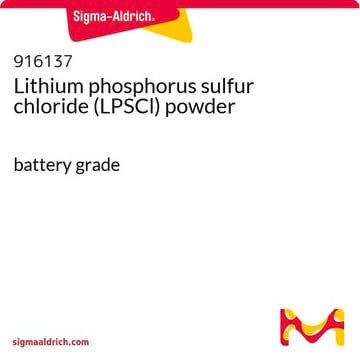213241
Lithium sulfide
99.98% trace metals basis
Synonym(s):
(lithiosulfanyl)lithium
About This Item
Recommended Products
grade
battery grade
assay
99.98% trace metals basis
form
powder
composition
Li2S
reaction suitability
reagent type: catalyst
core: lithium
density
1.66 g/mL at 25 °C (lit.)
application(s)
battery manufacturing
battery manufacturing
storage temp.
2-8°C
SMILES string
[Li]S[Li]
InChI
1S/2Li.S
InChI key
ZWDBUTFCWLVLCQ-UHFFFAOYSA-N
Looking for similar products? Visit Product Comparison Guide
Related Categories
General description
Application
Features and Benefits
signalword
Danger
hcodes
Hazard Classifications
Acute Tox. 3 Oral - Eye Dam. 1 - Skin Corr. 1B
supp_hazards
Storage Class
6.1B - Non-combustible acute toxic Cat. 1 and 2 / very toxic hazardous materials
wgk_germany
WGK 3
flash_point_f
Not applicable
flash_point_c
Not applicable
ppe
Eyeshields, Faceshields, Gloves, type P3 (EN 143) respirator cartridges
Certificates of Analysis (COA)
Search for Certificates of Analysis (COA) by entering the products Lot/Batch Number. Lot and Batch Numbers can be found on a product’s label following the words ‘Lot’ or ‘Batch’.
Already Own This Product?
Find documentation for the products that you have recently purchased in the Document Library.
Customers Also Viewed
Our team of scientists has experience in all areas of research including Life Science, Material Science, Chemical Synthesis, Chromatography, Analytical and many others.
Contact Technical Service










